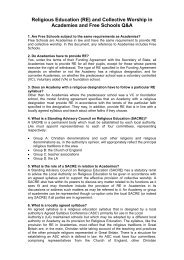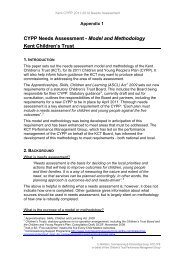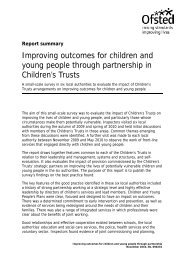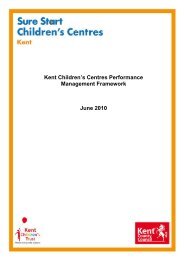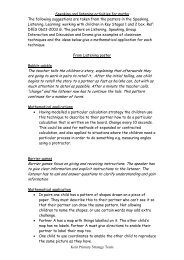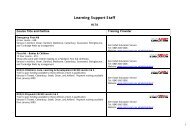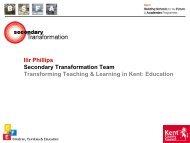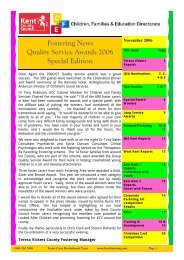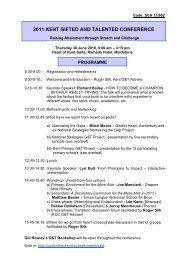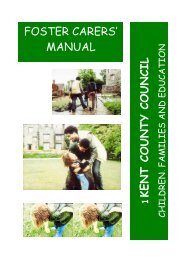Key Stage 1 - Kent Trust Web
Key Stage 1 - Kent Trust Web
Key Stage 1 - Kent Trust Web
You also want an ePaper? Increase the reach of your titles
YUMPU automatically turns print PDFs into web optimized ePapers that Google loves.
Writing assessment guidelines: levels 5 and 6<br />
Pupil name Class / Group Date<br />
Level 6<br />
AF5 - vary sentences for<br />
clarity, purpose and effect<br />
Across a range of writing<br />
• controlled use of a variety<br />
of simple and complex<br />
sentences to achieve<br />
purpose and contribute of<br />
overall effect<br />
• confident use of a range<br />
of sentence features to<br />
clarify or emphasise<br />
meaning, eg fronted<br />
adverbials (‘Reluctantly ,<br />
he …, Five days later, it<br />
…’), complex noun or<br />
prepositional phrases<br />
AF6 - write with<br />
technical accuracy of<br />
syntax and<br />
punctuation in<br />
phrases, clauses and<br />
sentences<br />
Across a range of<br />
writing<br />
• syntax and full range<br />
of punctuation are<br />
consistently accurate<br />
in a variety of<br />
sentence structures,<br />
with occasional<br />
errors in ambitious<br />
structures , eg only<br />
occasional comma<br />
splices, some use of<br />
semi-colons, not<br />
always accurate<br />
AF3 - organise and<br />
present whole texts<br />
effectively, sequencing<br />
and structuring<br />
information, ideas and<br />
events<br />
Across a range of writing<br />
• material is clearly<br />
controlled and<br />
sequenced, taking<br />
account of the reader’s<br />
likely reaction, eg<br />
paragraphs of different<br />
lengths, use of flashback<br />
in narrative, anticipating<br />
reader’s questions<br />
• a range of features<br />
clearly signal overall<br />
direction of the text for<br />
the reader, eg opening<br />
paragraphs that introduce<br />
themes clearly,<br />
paragraph markers, links<br />
between paragraphs<br />
AF4 - construct<br />
paragraphs and use<br />
cohesion within and<br />
between paragraphs<br />
Across a range of writing<br />
• construction of<br />
paragraphs clearly<br />
supports meaning and<br />
purpose, eg paragraph<br />
topic signalled and then<br />
developed, withholding of<br />
information for effect,<br />
thematic links between<br />
paragraphs<br />
• within paragraphs,<br />
cohesive devices<br />
contribute to emphasis<br />
and effect, eg adverbials<br />
as sentence starters<br />
AF1 - write imaginative,<br />
interesting and thoughtful<br />
texts<br />
AF2 - produce texts which are<br />
appropriate to task, reader and<br />
purpose<br />
Across a range of writing<br />
• imaginative treatment of appropriate materials, familiarity with<br />
conventions of a variety of forms, adapting them when needed to<br />
suit purpose and audience, not always successfully, eg deliberate<br />
use of inappropriate register for humour, clear emphasis on<br />
narration rather than plot<br />
• convincing, individual voice or point of view established and<br />
mostly sustained throughout, eg authoritative expert view,<br />
convincing characterisation, adopting a role<br />
• level of formality used for purpose and audience generally<br />
appropriate and a range of stylistic devices used to achieve effect<br />
not always successfully, eg controlled informality, generalisations<br />
or shifts between conversational style and more literary language<br />
AF7 - select<br />
appropriate and<br />
effective<br />
vocabulary<br />
Across a range of<br />
writing<br />
• vocabulary<br />
chosen generally<br />
appropriate to<br />
purpose and<br />
audience<br />
• range of<br />
vocabulary<br />
generally varied<br />
and often<br />
ambitious, even<br />
though choices<br />
not always apt<br />
AF8 - use correct spelling<br />
Across a range of writing<br />
• generally correct spelling<br />
throughout, including<br />
some<br />
o ambitious, uncommon<br />
words<br />
o words with complex<br />
sound/symbol<br />
relationships<br />
o words with unstressed<br />
syllables<br />
o multi-letter vowel and<br />
consonant symbols<br />
• likely errors<br />
o occasionally in complex<br />
words such as<br />
outrageous,<br />
exaggerated,<br />
announcing, parallel<br />
Level 5<br />
Across a range of writing<br />
• a variety of sentence<br />
lengths, structures and<br />
subjects provides clarity<br />
and emphasis<br />
• wider range of<br />
connectives used to<br />
clarify relationship<br />
between ideas, eg<br />
although, on the other<br />
hand, meanwhile<br />
• some features of<br />
sentence structure used<br />
to build up detail or<br />
convey shades of<br />
meaning, eg variation in<br />
word order, expansions in<br />
verb phrases<br />
Across a range of<br />
writing<br />
• full range of<br />
punctuation used<br />
accurately to<br />
demarcate<br />
sentences, including<br />
speech punctuation<br />
• syntax and<br />
punctuation within<br />
the sentence<br />
generally accurate<br />
including commas to<br />
mark clauses, though<br />
some errors occur<br />
where ambitious<br />
structures are<br />
attempted<br />
Across a range of writing<br />
• material is structured<br />
clearly, with sentences<br />
organised into<br />
appropriate paragraphs<br />
• development of material<br />
is effectively managed<br />
across text, eg closings<br />
refer back to openings<br />
• overall direction of the<br />
text supported by clear<br />
links between paragraphs<br />
Across a range of writing<br />
• paragraphs clearly<br />
structure main ideas<br />
across text to support<br />
purpose, eg clear<br />
chronological or logical<br />
links between paragraphs<br />
• within paragraphs /<br />
sections, a range of<br />
devices support<br />
cohesion, eg secure use<br />
of pronouns, connectives,<br />
references back to the<br />
text<br />
• links between paragraphs<br />
/ sections generally<br />
maintained across whole<br />
text<br />
Across a range of writing<br />
• relevant ideas and material<br />
developed with some<br />
imaginative detail<br />
• development of ideas and<br />
material appropriately<br />
shaped for selected from,<br />
eg nominalisation for<br />
succinctness<br />
• clear viewpoint established<br />
generally consistent, with<br />
some elaboration, eg some,<br />
uneven development of<br />
individual voice or<br />
characterisation in role<br />
Across a range of writing<br />
• main purpose of writing is clear<br />
and consistently maintained<br />
• features of selected form clearly<br />
established with some adaptation<br />
to purpose<br />
• appropriate style clearly<br />
established to maintain reader’s<br />
interest throughout<br />
Across a range of<br />
writing<br />
• vocabulary<br />
chosen for effect<br />
• reasonably wide<br />
vocabulary used,<br />
though not<br />
always<br />
appropriately<br />
Across a range of writing<br />
• correct spelling of<br />
o grammatical function<br />
words<br />
o almost all inflected<br />
words<br />
o most derivational<br />
suffixes and prefixes<br />
o most common<br />
content/lexical words<br />
• likely errors<br />
o occasional phonetically<br />
plausible spelling of<br />
unstressed in content<br />
words<br />
o double consonants in<br />
prefixes<br />
BL<br />
IE<br />
29<br />
Overall assessment (tick one box only) Low 5<br />
Secure 5 High 5 Low 6 Secure 6 High 6



